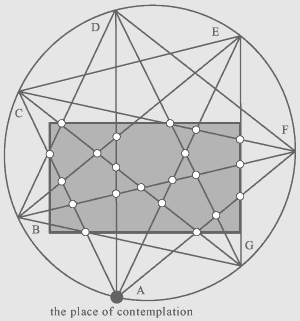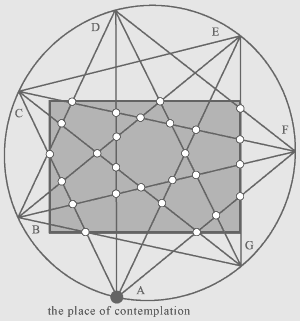Stones of a Japanese garden in a heptagonal network of lines can symbolize
not only seven astrological planets, that is told on the third page in this site
section, but also can symbolize many other physical and metaphysical objects of
world around, and in particular can symbolize letters. For example, in the
modern Latin alphabet there are 26 letters, but the primary Latin alphabet had
21 letters and consequently it is possible to arrange 7 groups of stones with 3
stones in each group (3x7=21) and to consider stones as symbols of letters A B C D E F Z H I K L M N O P Q R S T V
X in borders of a Japanese garden.
Look the detailed information on letters
of the primary Latin alphabet on pages of other site:
www.wordgame.64g.ru/meta/meta3en.htm.
Stones-symbols of letters can occupy all space of a heptagonal network of lines,
or borders of a garden within the framework of a heptagon can occupy a part of
space where the quantity of locuses (crossings of lines) is comparable to
quantity of letters, that is shown on the chart:
 |
White circles specify points where lines are crossed
within the limits of a grey rectangular which designates borders of a
Japanese garden of stones. The quantity of white circles within a grey
rectangular is equal to quantity of letters in the primary Latin
alphabet that supposes arrangements of 7 groups of stones with 3 stones
in each group, and allows to consider stones as symbols of letters. And
also allows to carry out games and puzzles in which players form words
in the event that moving stones is supposed. Comparison of stones in a Japanese garden with letters is a complex condition of game and a complex condition according to which the observer perceives stones, but such variant for understanding of philosophical concepts of a Japanese garden of stones nevertheless is possible. |
For realization of games and puzzles it is possible to involve not only letters of the primary Latin alphabet, but 26 letters of the modern Latin alphabet provided that the sizes of a garden within a heptagonal network of lines should have the appropriate quantity locuses for arrangements of stones-symbols of letters, as shown in the following chart:
 |
As it is possible to see, the quantity of white circles
(locuses) in borders of a grey rectangular is equal to quantity of
letters in the modern Latin alphabet that supposes arrangements of
stones which symbolize 26 letters of the Latin alphabet. Process of game or puzzle can consist that preliminary 26 stones-symbols of letters have in a point of contemplation, and then move from a locus to a locus by a heptagon agrees to those or other rules. And the task of game can consist in such moving as a result of which stones-symbols of letters form words. For example, on line BF it is possible to form a word which consists of six letters, and on line AE it is possible to form a word which consists of four letters, and two words have the common letter which is located in crossing of lines AE and BF. If all locuses of a garden are filled with stones-symbols of letters, and on each line there is a word, then game or puzzle is considered decided. |
It is possible to apply a rule according to which if on any line there is a
word then all stones-symbols of letters of this word collect in group in any one
locus of this line, then these stones become motionless but can be involved in
the following words which are formed during game or puzzle. If in result all
stones-symbols of letters in borders of a garden are collected in groups then
the puzzle is solved, and this decision can be considered as a geometrical
composition according to which stones of a Japanese garden will are located.
It is possible to have stones-symbols of letters in groups according to
linguistic laws, namely irrespective of rules of any games or puzzles but
according to sound harmonies of letters, or according to any alphabetic codes.
And also it is possible to take into account acoustic parameters of sounds
according to which it is possible to compare stones to letters.
It is possible to correlate letters of the primary Latin alphabet and stones of
a Japanese garden with the senior arcane (major arcana) of Tarot, which number
21 if not consider the zero arcane which has no a serial number. Namely it is
possible to combine stones in borders of a garden and within a heptagonal
network of lines as cards of Tarot, and it is possible to consider arrangements
of stones as combinations of cards Tarot. Or it is possible to take into account
the zero arcane of Tarot and to use 22 stones in a Japanese garden.
And also it is possible to compare stones of a Japanese garden to many other
physical both metaphysical objects and phenomena of world around.
The following page compares stones of a Japanese garden to letters of the modern Russian alphabet and gods of Vedic mythology, and also compares stones of a Japanese garden to numbers in numerology and gods of ancient Greek mythology.